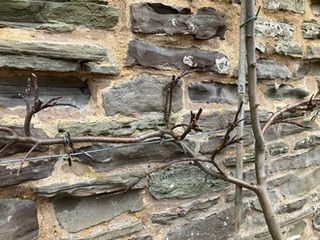JANUARY 2024
- boovaughan
- Jan 24, 2024
- 2 min read
Let’s start 2024 with a focus on apple tree pruning. Winter is the main season in the year for pruning trees, shrubs and woody climbers. This is especially true of most fruit trees. Two yearly prunings are carried out on apples,

the Summer prune, which restricts vegetative growth allowing light and air to reach the developing fruits and directing a greater portion of the tree’s ‘food’ to the fruits.
The Winter prune, which takes advantage of the dormant period to sculpt the tree into the most advantageous and efficient shape for fruit production.
Left to itself an apple will grow into a congested small tree, the branches reaching far upwards to out-compete others for light and spread its leaves over a large surface area. It will produce fruits sufficient for its seeds to be transported and sown elsewhere. Then parts may break as they become older and more brittle, disease enter, and the tree slowly die. The tree has done what’s needed. It has lived out its life, and passed its genetic material to the next generations. For the gardener or fruit producer however this can be made more efficient.

Apple trees can be formed into several shapes such as espaliers, cordons and bush trees. The bush trees are usually pruned into a wine goblet/ umbrella shape. In essence the tree is pruned so that only branches necessary for fruit production remain, and these are encouraged to grow horizontally. This gives the leaves a large surface area angled to the sun much like a solar panel, but also promotes the growth of fruiting spurs along the branches increasing the productivity of the framework.
Less congested trees take up less overall space allowing for other trees/ varieties to be planted, and there are fewer entry points for disease keeping the tree healthier and more productive for longer. With the fruits closer to the ground it also makes for easier harvesting.

Starting with a ‘maiden-whip’ an apple may be trained into a suitable form such as a bush or espalier. However if starting with an older, more ‘wild’ form then greater care needs to be taken. It may seem counterintuitive but pruning encourages growth!
So if you decide one winter to remove many of the thicker branches and all the congested growth you might have a ‘neat’ looking tree for a couple of months, but by summer the tree will have grown many ‘water-shoots’ - sappy, vegetative, unproductive shoots - as it tries to retrieve what its lost. The key is to prune the tree over a 3-5 year period removing each winter a third to a fifth of the tree’s total shoots. By this method the remainder of the tree will continue producing fruit, replenish shoots at a much more manageable speed, and these can be trained to production.
Finally a note on the three ‘D’s - dead, diseased and damaged.
When pruning, these shoots should be the first removed (cut back to healthy wood), and should they constitute a third or more of the tree’s canopy then remove these and leave any further pruning till the following winter.




Comments